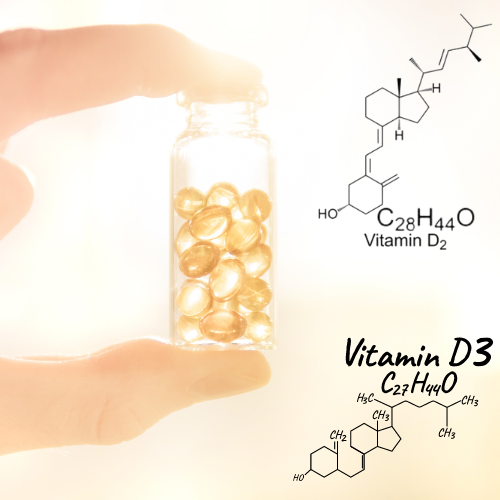
Vitamin D is fascinating
It’s a nutrient we can eat and a hormone our bodies make, and it helps keeps our bones healthy by aiding in the absorption and maintenance of calcium and phosphorus. The catch is few foods naturally contain vitamin D. It’s found in fatty fish, egg yolks, yogurt, and beef liver. However, some foods (usually for preservative reasons) are fortified with vitamin D (think cereals, milk, and juices). With this in mind, for most people, the best way to get enough vitamin D is by taking a supplement. These supplements are available in 2 forms: vitamin D2 (” ergocalciferol or pre-vitamin D) and vitamin D3 (“cholecalciferol”). Both are naturally occurring forms produced in the presence of the sun’s ultraviolet-B (UVB) rays, but D2 comes from plants and fungi and D3 in animals.
Are low levels of vitamin D a public health problem?
Worldwide, vitamin D deficiency is a significant public health concern. The problem is in all age groups, even in countries with low latitudes, where UV radiation is usually adequate to prevent this deficiency.
Although the primary source of vitamin D production happens in the skin, many people have insufficient sunlight exposure. The reason is that they live in places where sunlight is limited in winter or spend so much time living inside that they can go days or even weeks without seeing the sun. When I lived in Canada, the winter was about six months long. Even though Calgary was a sunny place, I would drive to work in the dark, work all day and drive home in the dark, not once going outside; not an excellent example from a health professional!
What are the health risks of low levels of Vitamin D?
Vitamin D deficiency in adults has increased the risk of developing various communicable and non-communicable diseases. For example, inadequate vitamin D levels have been linked to colon cancer, breast cancer, cardiovascular disease, diabetes mellitus, multiple sclerosis, rheumatoid arthritis, Parkinson’s disease, and tuberculosis
In addition, in the young, low levels can cause poor mineralization of the collagen matrix in children’s bones leading to growth retardation and bone deformities known as rickets. In adults, vitamin D deficiency induces secondary hyperparathyroidism, which causes bone matrix loss and minerals loss, thus increasing the risk of osteoporosis and fractures. A weak bone matrix in adults can also lead to painful bone diseases like osteomalacia and osteoporosis. These conditions can cause muscle weakness, increase the risk of falling and fractures, and severely affect overall health and well-being (1).
What are the causes of low levels of Vitamin D?
In the United Kingdom and similar latitudes, seasonal variation in the availability of sunlight, specifically UVB, affects the entire population. The time of year when this is the lease is the end of September to early March (autumn and winter in the Northern Hemisphere). During these seasons, 95% of healthy white adults and 83% of adolescents get poor light exposure (2).
In America, up to 40% of U.S. adults have insufficient vitamin D levels, which simply means they don’t have enough, and around 6% are deficient in vitamin D. This data is worrying as the fix should be relatively simple…sunlight or supplements.
I can see how this advice is at odds with the significant public health drive of the past few decades to reduce sun exposure because of increases in skin cancer. Leading to the general advice to minimize sun exposure at times when UVB is highest and encourage sun use protective measures when outside. Finding the right balance between sufficient sun exposure without the risk of skin cancer is complex; For those who like data, here it is:
What is the optimal amount?
Current research agrees that a circulating level of 25-hydroxyvitamin D of more than 75 nmol/L, or 30 ng/mL, is a healthy amount.
In the absence of adequate sun exposure, at least 800–1000 IU of vitamin D3/d may be needed to achieve this in children and adults. Vitamin D2 may be equally effective in maintaining circulating concentrations of 25-hydroxyvitamin D when given in physiologic concentrations (3).
Is vitamin D deficiency linked to inflammation and pain?
Beyond its critical function in bone health, vitamin D also plays an essential role in the immune system. Primarily it helps reduce inflammation by modulating cytokines and inhibiting the proliferation of pro-inflammatory cells.
However, it’s unclear if supplementation of vitamin D does the same thing for these pathways as getting it the old-fashioned way, via the sun.
2021 research from the University of South Australia, recently published in the International Journal of Epidemiology, examined random genetic data of 294,970 unrelated participants with White-British ancestry from the U.K. Biobank. They looked to show a correlation between vitamin D and C-reactive protein levels, one of the most widely used inflammatory biomarkers in clinical practice (4).
The researchers found evidence supporting the theory that vitamin D levels impact C-reactive protein levels (an indicator of inflammation), meaning that lower vitamin D equals more C-reactive protein.
The study’s results suggest that correcting a person’s vitamin D deficiency is likely to reduce inflammation and mitigate the risk or severity of chronic illnesses with inflammatory components. Therefore, the inflammation caused by vitamin D deficiency is reversible if vitamin D concentrations go back to normal levels.
With this in mind, getting your vitamin D levels is a must if you have high levels of inflammation or even a chronic disease. But, if they are low, it doesn’t mean that simply popping a vitamin D supplement will be a definitive way to prevent inflammation. Looking at all aspects of a healthy lifestyle and getting plenty of sunshine is still the best way to get enough vitamin D.
Vitamin D deficiency might play a role in the progression and occurrence of Scoliosis.
The mechanism behind idiopathic Scoliosis and its progression isn’t fully understood yet; however, more research and theories on genetic and non-genetic factors have been proposed to cause idiopathic Scoliosis in the past 20 years.
Among non-genetic factors is bone mineral density (BMD), as bone quality plays a vital role in the derangement of bony mechanical stability. Osteoporosis is known to lower bone strength, and the prevalence of adult-onset idiopathic Scoliosis with osteoporosis is about 20%–38% (5).
Vitamin D plays an essential role in maintaining a healthy mineralized skeleton. It helps with calcium absorption, and patients with vitamin D deficiency can have difficulties producing new bone and maintaining bone strength (6).
Studies have shown that people with idiopathic scoliosis with an average bone density have less or more moderate curves than those with a reduced bone density. It seems that people with low vitamin D levels might have a higher chance of developing scoliosis, and if they already have scoliosis, they will have an increased chance of a more severe curve due to changes in their bone health.
Vitamin D is one of the body’s often overlooked yet essential substances. As we evolved, we would have been exposed to vast amounts of sunlight; through evolution, we would not have needed to develop the physiology to produce it inside our bodies. However, our modern style of living is vastly different, the amount of sun the vast majority of us are exposed to daily, and as a result, our health is suffering. There is an easy fix, go outside to get some light on your skin, and if that isn’t possible, take a supplement.

Over the last 10 years Ed has been building a YouTube library to help people manage their own pain or movement limitations and increase performance through exercise. He regularly adds videos so be sure to subscribe and visit regularly


"Oh My Gosh- I am ALREADY feeling relief after a few days! I used to wake up 2-3 times a night with shooting pain that anti inflammatories couldn't touch. Now I have been waking up just because I want to notice what it feels like to lay in bed pain free- THANK YOU!."

"When I first started with your program I was experience a lot of pain. Walking was difficult. I had to stop and catch my breath every few minutes and lean against a wall for support. Now when I walk with my husband we go for over an hour. I never had to sit down and stop...and, hardly any pain!!! 😊😊 I can’t thank you enough."
Frustrated that you aren't recovering fast enough?
Discover how to heal from illness and injury using movement, food and lifestyle.